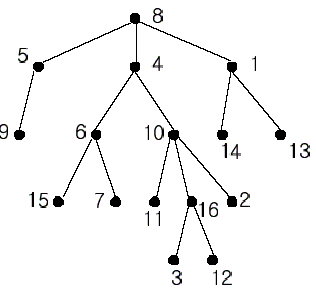Description
A rooted tree is a well-known data structure in computer science and engineering. An example is shown below:

In the figure, each node is labeled with an integer from {1, 2,...,16}. Node 8 is the root of the tree. Node x is an ancestor of node y if node x is in the path between the root and node y. For example, node 4 is an ancestor of node 16. Node 10 is also an ancestor of node 16. As a matter of fact, nodes 8, 4, 10, and 16 are the ancestors of node 16. Remember that a node is an ancestor of itself. Nodes 8, 4, 6, and 7 are the ancestors of node 7. A node x is called a common ancestor of two different nodes y and z if node x is an ancestor of node y and an ancestor of node z. Thus, nodes 8 and 4 are the common ancestors of nodes 16 and 7. A node x is called the nearest common ancestor of nodes y and z if x is a common ancestor of y and z and nearest to y and z among their common ancestors. Hence, the nearest common ancestor of nodes 16 and 7 is node 4. Node 4 is nearer to nodes 16 and 7 than node 8 is.
For other examples, the nearest common ancestor of nodes 2 and 3 is node 10, the nearest common ancestor of nodes 6 and 13 is node 8, and the nearest common ancestor of nodes 4 and 12 is node 4. In the last example, if y is an ancestor of z, then the nearest common ancestor of y and z is y.
Write a program that finds the nearest common ancestor of two distinct nodes in a tree.

In the figure, each node is labeled with an integer from {1, 2,...,16}. Node 8 is the root of the tree. Node x is an ancestor of node y if node x is in the path between the root and node y. For example, node 4 is an ancestor of node 16. Node 10 is also an ancestor of node 16. As a matter of fact, nodes 8, 4, 10, and 16 are the ancestors of node 16. Remember that a node is an ancestor of itself. Nodes 8, 4, 6, and 7 are the ancestors of node 7. A node x is called a common ancestor of two different nodes y and z if node x is an ancestor of node y and an ancestor of node z. Thus, nodes 8 and 4 are the common ancestors of nodes 16 and 7. A node x is called the nearest common ancestor of nodes y and z if x is a common ancestor of y and z and nearest to y and z among their common ancestors. Hence, the nearest common ancestor of nodes 16 and 7 is node 4. Node 4 is nearer to nodes 16 and 7 than node 8 is.
For other examples, the nearest common ancestor of nodes 2 and 3 is node 10, the nearest common ancestor of nodes 6 and 13 is node 8, and the nearest common ancestor of nodes 4 and 12 is node 4. In the last example, if y is an ancestor of z, then the nearest common ancestor of y and z is y.
Write a program that finds the nearest common ancestor of two distinct nodes in a tree.
Input
The input consists of T test cases. The number of test cases (T) is given in the first line of the input file. Each test case starts
with a line containing an integer N , the number of nodes in a tree, 2<=N<=10,000. The nodes are labeled with integers 1, 2,..., N. Each of the next N -1 lines contains a pair of integers that represent an edge --the first integer is the parent node of the
second integer. Note that a tree with N nodes has exactly N - 1 edges. The last line of each test case contains two distinct integers whose nearest common ancestor is to be computed.
Output
Print exactly one line for each test case. The line should contain the integer that is the nearest common ancestor.
Sample Input
2
16
1 14
8 5
10 16
5 9
4 6
8 4
4 10
1 13
6 15
10 11
6 7
10 2
16 3
8 1
16 12
16 7
5
2 3
3 4
3 1
1 5
3 5
Sample Output
4
3
这道题是一个LCA,可以树上倍增解决,下面是程序:
#include<stdio.h>
#include<string.h>
#include<stdlib.h>
#include<iostream>
using namespace std;
struct edge{
int v;
edge *next;
}*head[10005];
int f[10005][20],d[10005];
edge *make(){
return (edge *)(malloc(sizeof(edge)));
}
int read(){
int s=0;
char c=getchar();
while(c<'0'||c>'9'){
c=getchar();
}
while(c>='0'&&c<='9'){
s*=10;
s+=c-'0';
c=getchar();
}
return s;
}
void add(int u,int v){
edge *x=make();
x->v=v;
x->next=head[u];
head[u]=x;
}
void dfs(int r,int h){
edge *now=head[r];
d[r]=h;
while(now){
if(!d[now->v]){
dfs(now->v,h+1);
}
edge *tp=now->next;
free(now);
now=tp;
}
}
int ask(int u,int v){
if(d[u]<d[v]){
swap(u,v);
}
int i,tp=d[u]-d[v];
for(i=0;i<15;i++){
if((1<<i)&tp){
u=f[u][i];
}
}
if(u==v){
return u;
}
for(i=15;i>=0;i--){
if(f[u][i]!=f[v][i]){
u=f[u][i];
v=f[v][i];
}
}
return f[u][0];
}
void work(){
memset(f,0,sizeof(f));
memset(head,0,sizeof(head));
memset(d,0,sizeof(d));
int n=read(),i,u,v,j;
for(i=1;i<n;i++){
u=read();
v=read();
f[v][0]=u;
add(u,v);
}
u=read();
v=read();
for(i=1;f[i][0];i++);
dfs(i,1);
for(j=1;(1<<j)<=n;j++){
for(i=1;i<=n;i++){
f[i][j]=f[f[i][j-1]][j-1];
}
}
printf("%d\n",ask(u,v));
}
int main(){
int t=read();
while(t--){
work();
}
return 0;
}







 本文介绍了一种求解树中两节点最近公共祖先(LCA)问题的有效算法——树上倍增法,并通过一个具体的例子展示了算法的实现过程。该算法首先进行预处理,记录每个节点的祖先信息,然后通过递归上升的方式找到两个节点的最近公共祖先。
本文介绍了一种求解树中两节点最近公共祖先(LCA)问题的有效算法——树上倍增法,并通过一个具体的例子展示了算法的实现过程。该算法首先进行预处理,记录每个节点的祖先信息,然后通过递归上升的方式找到两个节点的最近公共祖先。
















 509
509

 被折叠的 条评论
为什么被折叠?
被折叠的 条评论
为什么被折叠?








